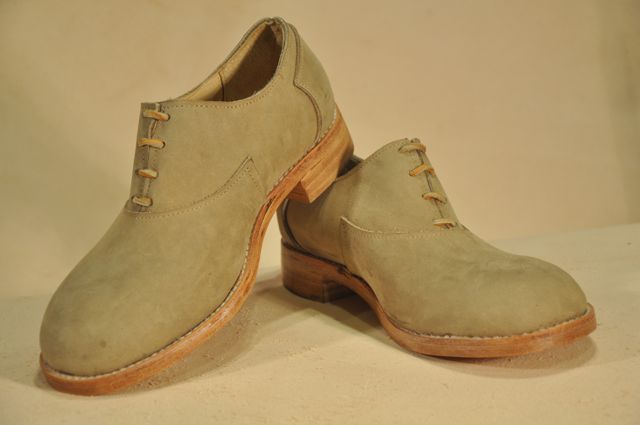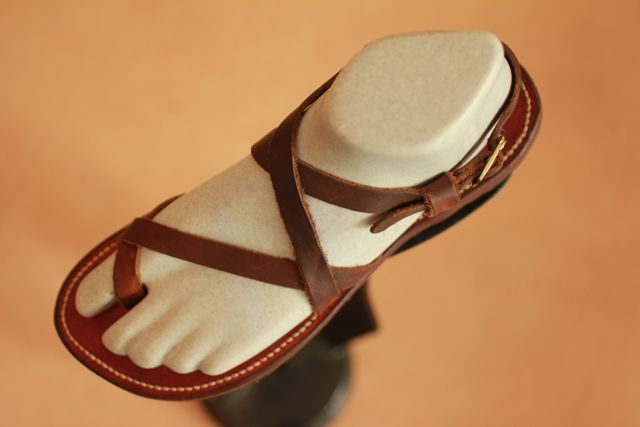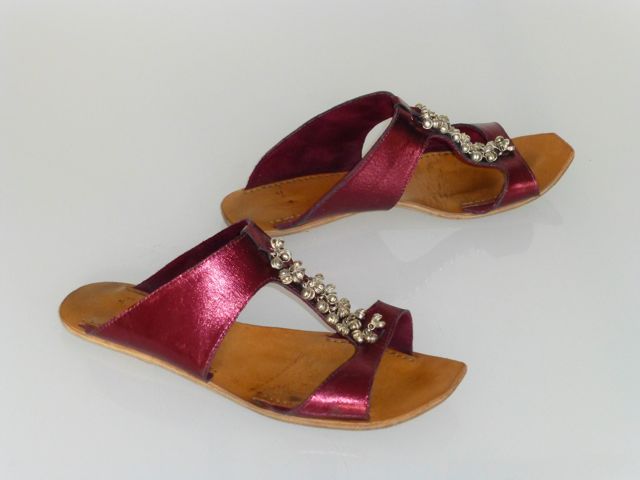Sandals by Nathalie Mornu
Nathalie Mornu knows how to take a compliment. “When strangers admire my sandals, I like to say, in a blasé tone, ‘Why thank you, I made them myself,’” she says. “I mean, how many people can say that?”
The local sandal maker adds, “I have to admit, I like being able to do something very few people can, something most folks wouldn’t even think to try for themselves.”
She’s got a point: Shoemaking is an atypical craft specialty. Historically, the art is associated more with trade workers, and the widespread practice fell by the wayside due to industrialization and the economics of the global marketplace. But the craft community knows that well-constructed, functional objects can be things of beauty, so shoemaking is finding a (ahem) toehold within the craft scene.

Oxfords by Jessica Brommer
But those interested in making footwear find few places in the nation to learn the skill. Locally, John C. Campbell Folk School and Penland School of Crafts offer workshops, and shoemaker Jessica Brommer is teaching small classes in her Asheville studio.
Amid the burgeoning interest, one business has been handcrafting footwear in Asheville since 1995: Paul Taylor Sandals on Wall Street still produces the styles that originated from Taylor’s cordwainer beginnings in Greenwich Village in the ’60s. A few years ago, the shop owner was preparing to retire when his business piqued the interest of Evar Hecht. “When I started researching how many people were sandal makers, there weren’t that many,” says Hecht, who was running a contracting company at the time. Nationally, “there’s about between 10 and 15 who do it full time as a business.”
He joined their ranks.
The custom sandal shop fits each shoe to its buyer’s foot and sells 200-300 pairs annually. After getting his feet wet for the first two years, Hecht began to expand the company’s offering to include wallets, bags and belts. His next strategy is to grow his online marketplace. To offer online shoppers the same level of customization, a fitting kit is sent by mail and includes material samples and tools for tracing and measuring the foot in need of shodding.

A time-tested style by Paul Taylor Sandals
Mornu came to sandal production from a background in craft. She also worked on the editorial staff at Lark Books, where her involvement with a book on leather jewelry sparked an exploration of leatherworking. “I had a bunch of extra leather lying around and a book that described how to make hippie sandals,” she says. “The end product in the book looked a little rough, and what I made following the instructions came out a bit crude, but the sandals were serviceable and comfortable.”
Shoemaking has been described as wearable art. Mornu’s sandal designs — evolved from that first rough pair — are strappy and feminine. Her mission is to “make it strong and comfortable without looking heavy.”
Mornu’s favorite part of the process is hand stitching the straps to the sole to reinforce the cemented construction. “I use waxed linen that’s pleasantly sticky to the touch. I pre-punch the holes that I sew through, and then I can zone out while I stitch,” she says. “The result looks perfect, yet it’s effortless. And the stitching is visual, tactile proof of the handwork.”
Both Mornu and Hecht have taken a workshop led by Brommer. Following a career as a fine art painter and a stint running a clothing shop in Asheville, Brommer turned to the Internet in search of a new direction. “I came across something that said, ‘Nobody makes shoes anymore,’” she says. The idea struck her as both true and shocking. “We import up to about 80 percent of the shoes we wear in this country, and we used to be a major exporter of shoes,” she says. “By the mid-’80s, all of it was offshored.”
Brommer has big ideas for how a handcrafted line of footwear can bring manufacturing back to the region. Speaking of her current business and what she hopes it will grow into, Brommer says, “It started very quietly, and it’s sort of growing and building its own momentum, which is exactly what I want. I want it to be something that’s about to sustain itself.”




Before you comment
The comments section is here to provide a platform for civil dialogue on the issues we face together as a local community. Xpress is committed to offering this platform for all voices, but when the tone of the discussion gets nasty or strays off topic, we believe many people choose not to participate. Xpress editors are determined to moderate comments to ensure a constructive interchange is maintained. All comments judged not to be in keeping with the spirit of civil discourse will be removed and repeat violators will be banned. See here for our terms of service. Thank you for being part of this effort to promote respectful discussion.